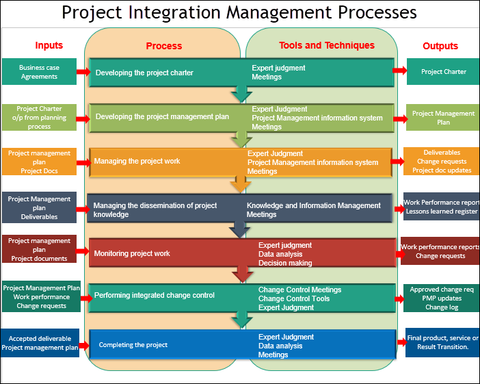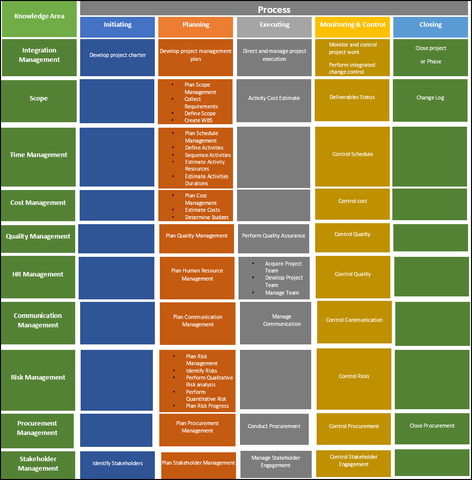Improving Project Outcomes With Proper Project Integration Management
Project Integration Management
Project Integration Management improves the project management process by organizing and coordinating the activities. Because it accounts for resource allocation, managing interdependencies, and balancing competing goals, it is an effective methodology to approach project management.

Project Integration Management
Project Integration Management Basics
Project integration management involves coordinating the various components of a project, including the objectives, stakeholders, resources, and activities. It may also incorporate conflict management as it pertains to the varying components and constituents and the evaluation of resources to support competing agendas.
The decision between coming in under budget and finishing on time is an example of project integration management because it involves evaluating multiple factors against the goal.
The concept of integrated project management prevents projects from being managed without coordination with the whole. This holistic approach considers how elements of the project relate to each other and the organization.
Project Management Process Groups
There are 47 processes in project management, which are grouped into ten Knowledge Areas mapped to the five Process Groups.
Process Groups
The five process groups in the project life cycle include Initiating, Planning, Executing, Monitoring/Controlling, and Closing. These make up the headings of each column when you organize your project. To effectively manage the project, it is important to understand the inputs, tools, techniques, and outputs for each process group. Examples are provided indicated in the table:
|
Inputs |
Tools / Techniques |
Outputs |
|
|
Initiating |
Meetings |
Project charter |
|
|
Planning |
Project charter |
Meetings |
Project plan |
|
Executing |
Work performance information |
Meetings |
Project document updates |
|
Monitoring / Controlling |
Process assets |
Meetings |
Work performance report |
|
Closing |
Project charter |
Meetings |
Closing summary |
Project Management Knowledge Areas
The 10 knowledge areas include Integration Management, Scope Management, Time Management, Cost Management, Quality Management, Human Resources Management, Communication Management, Risk Management, Procurement Management, and Stakeholders Management. These comprise the row headers.
All of the activities fall into a grid that, when organized, looks something like this.

Project Management Process Groups
|
Initiating |
Planning |
Executing |
Monitoring / Controlling |
Closing |
|
|
Integration Management |
Develop Project Charter |
Develop Project Management Plan |
Direct and Manage Project Work |
Monitor and control Project Work, Perform integrated Change Control |
Close Project or Phase |
|
Scope Management |
Plan Scope Management, Collect Requirements, Define Scope, Create WBS |
Activity Cost Estimate |
Deliverables Status |
||
|
Time Management |
Plan Schedule Management, Define Activities, Sequence Activities, Estimate Activity Resources, Estimate Activities Durations, Develop Schedule |
Control Schedule |
|||
|
Cost Management |
Plan Cost Management, Estimate Costs, Determine Budget |
Control Cost |
|||
|
Quality Management |
Plan Quality Management |
Perform Quality Assurance |
Control Quality |
||
|
HR Management |
Plan Human Resource Management |
Acquire Project Team, Develop Project Team, Manage Project Team |
|||
|
Communication Management |
Plan Communication Management |
Manage Communication |
Control Communication |
||
|
Risk Management |
Plan Risk Management, Identify Risks, Perform Qualitative Risk analysis, Perform Quantitative Risk, Plan Risk Progress |
Control Risks |
|||
|
Procurement Management |
Plan Procurement Management |
Conduct Procurement |
Control Procurement |
Close Procurement |
|
|
Stakeholder Management |
Identify Stakeholders |
Plan Stakeholder Management |
Manage Stakeholder Engagement |
Control Stakeholder Engagement |
Project Integration Management Processes
There are seven project integration management processes that are essential.
These include:
- Developing The Project Charter: This is the phase where the mission is evaluated and the goals defined so that there is clarity as the project evolves. Doing this well makes it possible for better decisions to be made throughout the project.
Check out the Project Charter Template here
- Developing The Project Management Plan: This is when the plan is designed, accounting for the resources, tasks, and timing.
Check out the Project management plan here
- Managing The Project Work: During this phase, active efforts must be taken to ensure all team members are working toward the goal. Realignment of priorities is key at this stage.
- Managing The Dissemination Of Project Knowledge: Effective communication of key information is an often overlooked step. As projects evolve, pockets of information are collected by constituents. Effective managers recognize this and take steps to share the information with all constituents.
- Monitoring Project Work: This effort should be incorporated throughout the project to ensure that all efforts are up to the defined standards. This will ensure key misses don’t occur.
- Performing Integrated Change Control: This involves reviewing change requests to approve or deny changes, manage their impact on the big picture, organize the information, document the changes, and communicate key information to involved parties.
- Completing The Project: This involves ensuring that the project crosses the finish line and achieves the objectives. This often-overlooked step closes the loop on all essential details and ensures that future projects can leverage the learning from previous efforts.
Project Integration Management Deliverables
To successfully manage all parts of a given project, the discipline of project integration management creates deliverables that include the project charter scope statement and plan.
- The Project Charter: The project charter states the goals and objectives and defines the roles and responsibilities for the project's onset. Used as the foundation document for the project, it is held by the project manager to drive the initiative to completion.
- Scope Statement: The scope statement is a living document intended to be edited as the scope changes. It defines the parts of the project's part sights the work to be completed, setting forth a success measure.
Check out the Project Scope Statement Template here.
- Project Management Plan: The project management plan describes how the various processes may coordinate to achieve optimal efficiency and productivity. It is included in the project plan and is designed to effectively guide the project.
Project Stages
Though projects vary in scope and complexity, they share five common stages: project initiation, planning, execution, monitoring, and closure.
Project Initiation is the start of the project. This stage's primary objective is to come to a consensus on the broad definition of the project. Research regarding the feasibility of a project is undertaken at this phase, and the requirements of the project are defined explicitly with the business case, stakeholders, etc.
Planning involves the creation of a plan that everyone can follow. Clear, quantifiable goals are spelled out, and things like costs, resources, and timetable are assessed. Accountability plans are also created to help keep the project on track.
During the execution stage, deliverables are created and completed. Likened to the meat of the project, there is a great deal that takes place during this stage, including:
- The development of the team.
- Assignment of resources.
- Execution of project management plans.
- Task assignment and status meetings.
- Scheduling and more.
Finally, when the project is completed, there is a period of closure of the project's closures and failures will be reviewed to develop future improvements and plans for future improvements developed at this point.
Improve Project Integration Management with Techno Project Management
Effective project integration management is key to the success of any project. Balancing competing needs can be challenging, and planning, especially amid uncertain times, can be challenging. Levering the proper visualization tools for complex scenarios is a key factor in project management success.




